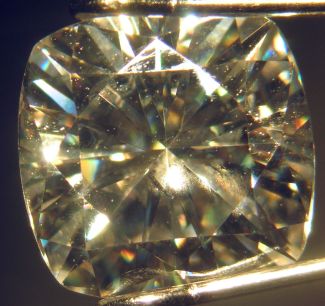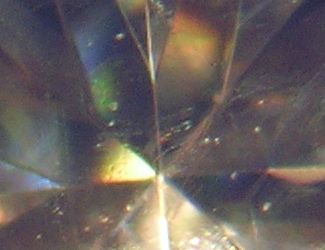Moissanite
A clear stone, similar to diamond, but man-made.
It's probably the most expensive diamond simulant, and in our opinion is best
enjoyed for its unique qualities.
While it's not as hard as diamond (nothing
is), it's tougher, and less brittle, so it should last
for many years. It also has more fire than a genuine diamond.
Distinguishing it from a diamond
Most people with an interest in precious stones will be able to tell the 2 stones apart. Here are some pointers:
- Most moissanite looks greener than diamonds (which tend to be yellow or blue). This test is not certain to work.
- Moissanite has more fire (it sparkles more, and shows more colour in the reflections) than diamond.
- Moissanite is free of inclusions. Almost all diamonds have some. It's possible that moissanite could be made with inclusions, but as far as I know it's never been done.
- Seen under magnification, the back facet edges appear doubled (see picture). This does not happen with diamonds. This is definitive.
Caring for Moissanite
The stones are tough, and should stand up to all normal cleaning methods, and to normal wear and tear.
Appreciate Moissanite for its Beauty
While it is often sold for
its similarity to diamond, in our judgement it's best enjoyed for its own unique
qualities. We consider CZ to be closer to diamond in
appearance.
Moissanite will sparkle more, and is very tough, lacking the
brittle nature of many precious gemstones.
For a man-made stone, it is
expensive, and there may be problems re-selling it. Our customers prefer
natural gems, so we would be reluctant to pay a reasonable percentage of the new
price for moissanite. However they may be a specialised market for
jewellery including these stones.

 Above, a typical moissanite. Note the amount of reflection and fire,
more than you would see in a diamond. The white spots are dust on the surface; sorry, but I wan't as careful as usual in cleaning this stone!
Above, a typical moissanite. Note the amount of reflection and fire,
more than you would see in a diamond. The white spots are dust on the surface; sorry, but I wan't as careful as usual in cleaning this stone!
